Official Name
Скопје (Skopje). The Romans called the place Scupi. During the Ottoman occupation - until the year 1912 - the town was known as Uskub resp. Üsküb
Location
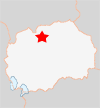
| ||
| Skopje |
Skopje straddles the Вардар (Vardar) river in the centre of Northern Macedonia. To →Kosovo in the north it's only 15 kilometres, the border to →Serbia is 40 km away. The town itself is quite hilly. In the south-west, there's a bigger mountain with a huge cross on the top of it, which is lit up at night and therefore easy to spot. The 'real' mountains start some kilometres away west of Skopje.
Population
Around 600,000 inhabitants. Skopje is by far the biggest town in the country. Almost every third Macedonian lives in the capital.
Orientation
Skopje is divided by the slightly winding river Vardar into a northeastern and southwestern part. The centre of town is marked by the characteristic Камен Мост (Kamen Most, Stone Bridge), an old Turkish bridge spanning the river Vardar. North-east of the bridge, there's an old fortress and the part of the old town that has survived the earthquake. Right below the fortress and close to the river, there's the Автобуска Станица (Avtobuska Staniza, bus terminal) of Skopje, from where all national and international buses start. A few metres to the east, and you will find yourself in the old town centre with its certain Turkish atmosphere, many small lanes and a few mosques. The Информации (Tourist information is hidden in the middle of the old town. Staff there is very friendly and has a lot of English material about the town and the country. East of the old town there's the large Универзитет Кирил и Методиј (Universitet Kyril i Metodij, University of St Cyril and St Methodius) - nothing less than Macedonia's most important university.
The district on the other side of the Stone Bridge looks completely different. Right behind the bridge there's the vibrant пл. Македонија (pl. Makedonija (Macedonia Square, formerly known as Маршал Тито Marshal Tito Square). A large and ugly concrete block faces Macedonia Square on the left side - that's the Трговски Центар (Trgovski Zentar, trade centre), used as a large shopping centre. Everything around Macedonia Square needed to be rebuilt after the quake, and so it doesn't come as a surprise that many of the buildings are not really attractive. When you walk from the square along the pedestrian zone ул. Македонија (ul. Makedonija, ul.= street) to the south, you will immediately get to the Стара Железничка Станица (Stara Shelesnichka Staniza, Old Train Station), which wasn't rebuilt after the quake in order to keep it as a monument (see picture below). The Транспортен Центар Жел. Ст. Transporten Zentar Shel. St. (New Central Station) was erected 1.5 km east of the old train station. The new train station was planned by Tange Kenzō, the architect of the giant →Tōkyō City Hall. Indeed, the train station of Skopje has this certain touch of modern Japanese architecture - but somehow it won't fit...
New Skopje with all of its more or less modern residential and industrial areas stretches northwards along the river Varda. Skopje is many kilometres long, but the historic centre is very compact, and so everything is within walking distance.
History
Geostrategically spoken, Skopje's location is almost perfect. It lies in the geographical centre of the Balkan peninsula, and thanks to the topography it was easy to defend.
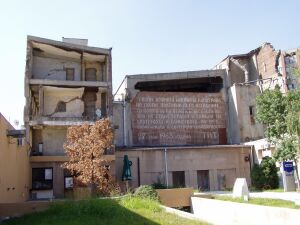
| ||
| The old train station, destroyed by the quake |
Which is probably exactly what the ancient Romans thought when they arrived. They founded a town, named it Scupi and made it the capital of the Province Dardania (Dardanians were an Illyrian tribe once settling in the area). After the decline of the Roman Empire, Skopje was conquered many times by Byzantines, Bulgarians, Normans, Serbians and so on. However, at that time, →Ohrid was culturally and politically much more important than Skopje.
After the fall of the →Second Bulgarian Empire in 1392, the Ottomans took over and remained in the country until the year 1912. During that time, the town was known as Üsküb. Although the country suffered a lot during the next decades, Skopje managed to escape war damage almost completely. Instead of that, the damage was done by a severe earthquake in July 1963. An estimated 1,000 citizens were killed and 80% of the buildings heavily damaged. International solidarity started right after the quake, but a lot of money was wasted for partially useless and outsized projects. Today, Skopje is the modern capital of small Macedonia. Recently, the town struggles with problems such as high unemployment.
Getting there / transportation
The international airport is called Аеродром Петровец Aerodrom Petrovez and lies more than 20 km outside Skopje in the east. There's a daily direct from →Belgrade via Skopje to Thessaloniki (here known as Солун, Solun!) in Greece. There aren't many national trains, so it's better to get around by bus. The ticket to Belgrade costs 1,226 MKD (€ 20) , the discount ticket Wasteels 26 (international discount for 26 yrs old or younger travelers) costs 981 MKD (€ 16). A berth in the sleeper car will set you back another € 10 - to be paid inside the train. The ride from Skopje to Belgrade takes almost 10 hrs, but the sleeper is very convenient. The train departs at around 21:30 from Skopje New Central.
Buses to →Ohrid start from the bus terminal below Vale fortress in Skopje. There are several daily buses. The shortest route is via Кичево & Тетово (Kičevo and Tetovo). Some buses stop in Tetovo, others just pass the city. Without a stopover, it takes 3½ hrs, with a stopover it's one hour more. The fare is 340 MKD (less than € 6) per person. Some buses go via Битола & Прилеп (Bitola and Prilep), which is quite a long way, so it takes much more time and the fare is higher. There are many buses, but they fill up quickly, so it might be wise to buy tickets in advance.
Buses from and to →Sofia start from the bus bus terminal behind Princess Hotel in Sofia and run to the Main Bus Station below the fortress in Skopje. The fare is € 10 per person, the ride takes around 5 hrs. There are two to three buses a day.
There's plenty to see in Skopje - and everything is conveniently located within walking distance. First a few remarks upon the old town:
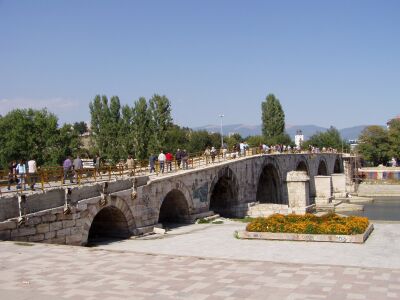
| ||
| The old Turkish bridge over the river Vardar |
As already mentioned above, the absolute centre of town is marked by the so-called Камен Мост (Kamen Most, Stone Bridge). The first bridge was already built in the 6th century, but the bridge as it can be seen today probably dates back to the 15th centuries. The bridge is quite narrow and therefore closed to traffic. Today, street vendors are loitering on the bridge selling mostly useless stuff.
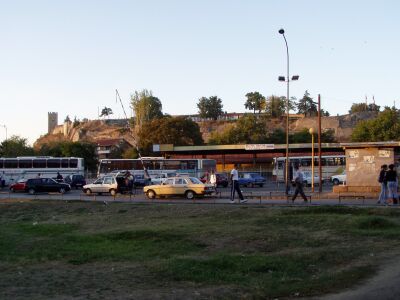
| ||
| The old fortress and the bus station |
Only a few dozen metres north of the Stone Bridge there's the Тврдна Кале Tvrdna Kale (Kale fortress). No, 'Tvrdna' is no typo - that's the typical lack of vowels in Slavic languages. The fortress was built in the 11th century, but only some walls are left. It's more a formidable park than a fortress, offering a stunning view over the whole old town. Right below the fortress there's the bustling national and international bus station - there are other bus stations in town, but this is the most important one.
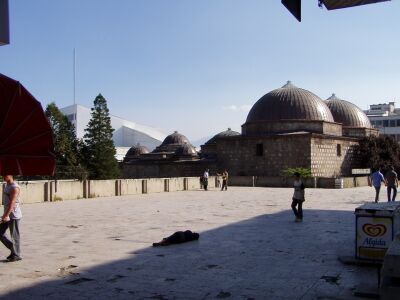
| ||
| The old Turkish bath in the historic centre - and a sleeper |
When you walk north from the Stone Bridge along the pedestrian zone, you will soon see the remainings of the Дауд Паша (Daud Pasha - Bath), which was probably built in the around the year 1466. At that time, it was the largest Turkish Bath in the Balkans. Nowadays, the Bath houses some exhibition rooms and an art gallery.
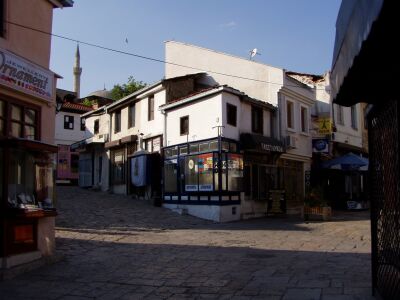
| ||
| The heavily Turkish influenced old district Charshija |
From Daud Pasha Bath, you will only need to walk up the stairs to the north before you enter the 'real' old town. The oldest remaining district of Skopje is called Чаршиjа (Charshiya, Čaršija). This part looks like a genuine oriental bazaar with all the necessary facilities such as tea parlours, barber shops. some bars, restaurants (most of them of course serving Turkish cuisine) and so on - this could be →İstanbul or any other old Turkish town. Additionally, mosques complete the picture. Among other interesting places, there's the old, traditional Куршумли Хан (Kurshumli Khan Caravanserai) and behind that the Музеј на Македонија (Museum of Macedonia).
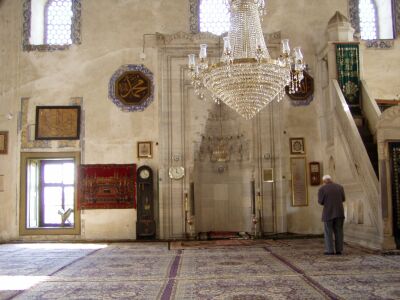
| ||
| Inside Mustafa Pasha Mosque |
One of the biggest mosques in town is called Мустафа Пашина (Mustafa Pasha-Mosque in the old town oppposite the fortress. This mosque was built in 1492. The dome was seriously damaged by the quake in 1963, leaving a visible crack in the roof. The imam of the mosque is a very old man, offering us to show us around in the mosque. He was very kind and patiently explained about this that, so that we left a small donation. Well, a mosque is a mosque, but it's always fascinating to see the different styles used in them. And it's like keaving Europe for a couple of minutes.
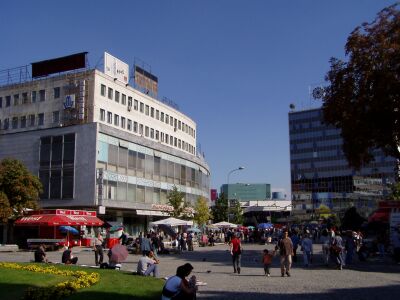
| ||
| Macedonia Square in the centre of town |
Back to the other side of the river: This part is dominated by the rebuilt districts. There's not so much to see, but this is the new, vibrant Skopje with all of its expensive boutiques, cafés and...hords of begging children.
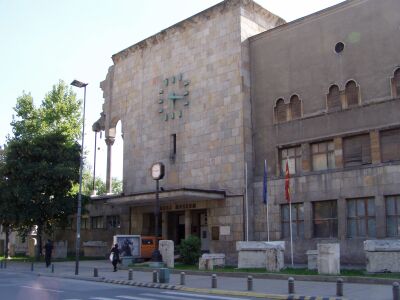
| ||
| The old train station of Skopje |
The entire city was reshaped and rebuilt after the desastrous quake. Except for one building, which was left on purpose. That's the old train station. Due to the heavy quake, the large clock stopped, making it a perfect monument commemorating the victims of the quake. Parts of the building remained intact and are now used by the Музеј на град Скопје (Skopje City Museum).
Sorry to say that, but since Macedonia is a very small country, everything can be called the 'surroundings' of Skopje. Virtually every place inside the country can be reached within 5 hours by bus. Less than 20 km to the south-west in a valley, there's the Матка (Matka) Lake, which is used as a recreation area by the stressed city dwellers.
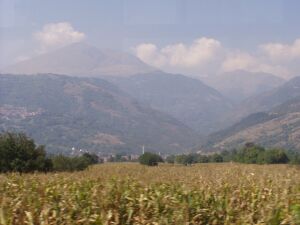
| ||
| Near Skopje: The mountains around Tetovo |
When you drive westwards for around thirty minutes, you will soon find yourself in Тетово (Tetovo), which is only around 30 km away. Tetovo belongs to the bigger towns of the country and is the main town of a region with a predominantly Albanian population. Fights between the Albanian minority and the government erupted in and around Tetovo in the years 2001/2. The spectacular mountains west and north of Tetovo, some of them more than 2,700 metres high, mark the Macedonian-Albanian border and were used by intruding UҪK fighters as a hideout. Things got better recently, but I guess it's still advisable to be very careful in the mountains, especially near the borderline.
It seems like there aren't many places to stay in Skopje. Actually there are some hotels, but most of them charge € 70 to € 200 for a double room. Private rooms cost at least € 20 per person. There's only one hostel in town - Дом Благој Шошолцев (Dom Blagoj Shosholchev Hostel). It's a member of the Youth Hostelling International Organization. The hostel is very modern and spotless clean. Non-members pay 1,280 MKD (€ 20), members pay 960 MKD (around € 15), which includes breakfast. A big restaurant with average quality and reasonable prices is attached to the hostel. However, there are better and cheaper restaurants in the vicinity. It's a 15 minutes walk from the hostel to the Stone Bridge.
How to get there: When you come out of the train station, walk left along the broad road crossing the tracks. The second street on the right is the Пролет (Prolet). After 200 metres you will see the hostel - it's easy to spot.
Address: Prolet 25; PO Box 499, 1000 Skopje. Tel.: (02)-3114 849, Fax.: (02)3165029.
- www.skopjeonline.com.mk English web directory about Skopje - everything you need.
Do you have or do you know a good website about Skopje? Don't hesitate, let me know! After checking it, I would love to add it to the link list. You can submit a link by using the →contact form. Note that commercial websites will be treated differently.
©2024 Europe-East.com

 Albania
Albania Macedonia
Macedonia